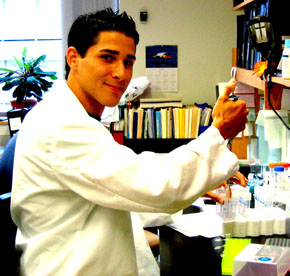
Damián Cabrera
University of Puerto Rico at Mayaguez
Ploegh Laboratory
Mentor: You-Me Kim
Summer 2007
Cloning of Toll-like Receptor 7-DsRed and 9-DsRed
Our body is in constant contact with pathogens. Such microorganisms have to be recognized by the immune system before they cause infectious diseases. In mammalian cells Toll-like receptors (TLRs) recognize molecular patterns uniquely found in pathogens and activate immune system. To date, ten TLRs have been identified in humans. TLR-7 and TLR-9, who are found to be in the endoplasmic reticulum, recognize single stranded RNA and unmethylated CpG sequences, respectively. To study their intracellular localization and trafficking, we aimed to engineer by cloning, a version of TLR-7 and 9 tagged to a red fluorescence protein, DsRed. DNA sequences encoding TLR-7 and 9 were amplified by PCR using primers with sequences for restriction enzymes XhoI and SalI. The amplified TLR-7 and 9 products were ligated to a pRetroQ-DSRed-N1 vector that was previously digested with XhoI and SalI. Competent E . Coli cells were transformed with the ligated product and plated on LB/agar plate with ampicillin. The resulting colonies were inoculated in liquid LB media containing ampicillin. The plasmid of interest was purified from bacterial cells and correct insertion of TLR-7 and 9 sequences was verified by restriction digestion. The sequences of newly generated plasmids were further confirmed by dideoxynucleotide DNA sequencing. In order to determine if the engineered vector encodes the red fluorescence fusion proteins, mammalian cells were transfected with purified plasmid by the cationic- lipid mediated transfection method. The expression of TLR-7-DsRed and TLR-9-DSRed fusion proteins was accessed using fluorescent microscopy. The created construct can now be used to investigate intracellular localization and ligands induced trafficking of TLR-7 and 9 in live cells. Understanding Toll-like receptors signaling and regulation would lead to development of new therapeutics for treatment and prevention of infectious diseases and autoimmune diseases.